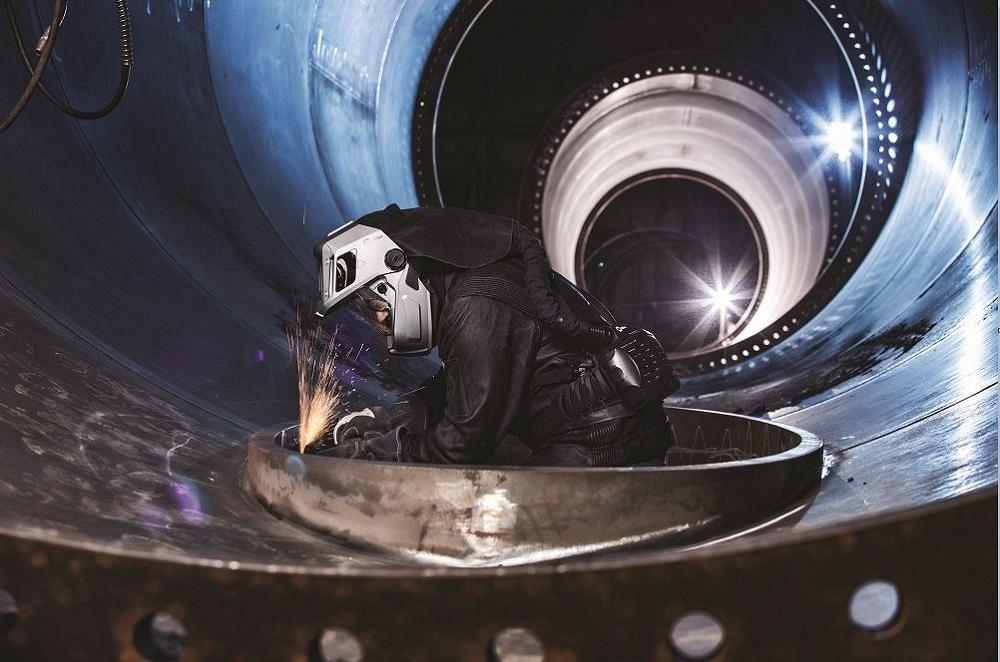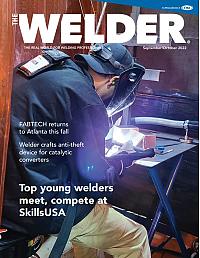Editor
- FMA
- The Fabricator
- FABTECH
- Canadian Metalworking
Categories
- Additive Manufacturing
- Aluminum Welding
- Arc Welding
- Assembly and Joining
- Automation and Robotics
- Bending and Forming
- Consumables
- Cutting and Weld Prep
- Electric Vehicles
- En Español
- Finishing
- Hydroforming
- Laser Cutting
- Laser Welding
- Machining
- Manufacturing Software
- Materials Handling
- Metals/Materials
- Oxyfuel Cutting
- Plasma Cutting
- Power Tools
- Punching and Other Holemaking
- Roll Forming
- Safety
- Sawing
- Shearing
- Shop Management
- Testing and Measuring
- Tube and Pipe Fabrication
- Tube and Pipe Production
- Waterjet Cutting
Industry Directory
Webcasts
Podcasts
FAB 40
Advertise
Subscribe
Account Login
Search
Considering powered air purifying respirator (PAPR) technology for welding
How this respiratory PPE option is considered less intimidating, more accessible, more comfortable
- By Rafael Guerrero
- October 5, 2022
- Article
- Safety

Advancements in powered air purifying respirator (PAPR) technology have made this PPE option less intimidating, more accessible, and more comfortable for welders and metalworkers to wear on the job. Images: Miller Electric Mfg. LLC
At first glance, a powered air purifying respirator (PAPR) may scare off some welders and metalworkers. After all, these respirators typically are a more expensive personal protective equipment (PPE) option and require welders to wear a belt pack with a hose running from it to the helmet.
Hesitations aside, this type of PPE is a solid option for welders worried about what goes into their lungs while under the hood. Welders can be exposed to hazardous metal and gas particles found in welding fumes. Exposure to these particles could eventually lead to respiratory illnesses and diseases such as bronchitis, asthma, emphysema, metal fume fever, and cancer.
Advancements in PAPR technology have made this PPE option much less intimidating, accessible, and even comfortable for welders considering such an option.
Welding and PAPRs
The PAPR gained relevancy in metalworking in the 2000s when the Occupational Health and Safety Administration (OSHA) released updated requirements regarding hexavalent chromium.
The particle is of particular concern in welding because it is considered toxic and can damage the eyes, skin, nose, throat, and lungs and potentially lead to cancer. As defined by OSHA, chromium is a component in stainless steel, nonferrous alloys, chromate coatings, and some welding consumables. During the welding process, chromium converts to its hexavalent state, Cr(VI).
“The PAPR technology—the use of a blower to pull air through a filter and pump it into a pressurized hood assembly—it’s been used in pharmaceuticals, powder-coat painting, grinding, even woodworking applications where there is potential for any airborne contaminants to be breathed in by individuals,” said Eric Sommers, product manager for respiratory protection at Miller Electric Mfg. LLC.
Since then, several manufacturers have released their own PAPR offerings varying in price, quality, and features that cater to metalworkers. Cost is arguably the biggest deterrent for customers, said Sommers. PAPR systems typically come with hefty price tags (some around $2,000), much more than half-mask respirators, which can fall in the $20 or $30 price range.
Shaun Relyea, tech support national manager for Fronius USAFRONIUS.COM, said a PAPR system is a great addition to any shop. However, as with all fume extraction systems, they do require maintenance, such as filter changes and charging the battery for the blower unit.
“The frequency of changing filters is really dependent on the environment one is working in,” Relyea said.
“If there’s a filter on, it has to be changed sooner or later,” he added.

A PAPR system uses a blower unit to pull air through a filter and pump it into a pressurized hood assembly. The respirator is not exclusive to metalworking as they can be found in pharmaceuticals, powder coating, grinding, woodworking, and other processes where there is potential for airborne contaminants to be breathed in by individuals.
Welders should be conscious that a PAPR system adds some weight to their gear and should be situationally aware of the air line running from the blower unit to the back of the helmet, Relyea explained.
Designs With Users in Mind
According to Sommers, the PAPR’s higher cost is countered by its benefits and what it can do.
One benefit is comfort, particularly in hot working environments.
“[A PAPR is] using the blower unit to pull the air through the filters as opposed to putting that burden on the welder. With half-mask respirators, you’re using your lungs to pull the air through, which can cause some fatigue, and in hot environments some people don’t like them,” he said
.“Having that blower pack provide that constant supply of fresh air alleviates the burden from a breathing perspective for the welder,” Sommers said.
Next, PAPRs provide an increased level of protection against airborne contaminants. The assigned protection factor (APF) measures a mask’s or respirator’s ability to protect users from contaminants, assuming the PPE is worn correctly. An APF of 10, for instance, means that the respirator can protect users from contaminant levels that are up to 10 times the permissible exposure limit. PAPR systems have an APF of 25, which means they can protect users from foreign contaminants better than half-mask respirators, which have a factor of 10.
New designs and feature additions have operator comfort in mind, Sommers added. Some manufacturers replaced the nickel-hydride batteries with lithium-ion batteries, which weigh less, making some units a couple of pounds lighter.
Additionally, the continued engineering of the air pathways from hose to helmet have led to lighter respirators. Moving hose locations from the top of the head to the nape of the neck, for instance, better distributes air to all sides of the face.
Shifting the respirator’s center of gravity and even adding shoulder straps have made them more comfortable to wear. Some models have adjustable blower speeds while others have LCD displays indicating battery, filter, and blower speed information.
“Just allowing more customization for that user will give them a much better experience,” Sommers said.
Furthermore, PAPR systems do not require a fitting test because they can be worn even with a beard.
“Beards are very popular right now, but you cannot wear a standard half-mask (respirator) with a beard; you have to be clean shaven,” said Sommers.
“It also makes it a little easier for the safety managers and supervisors implementing respiratory programs that they don’t have to do fit testing,” he said.
A PAPR system and its continuous, filtered air supply helps a welder’s respiratory well-being, added Relyea. Welding fumes are bad for one’s health and can be deadly, depending on the material.
“[A PAPR] blows fresh air while you’re welding,” Relyea said. “It really reduces how much fume is making it into your hood while working.”
He also recommends having a fume extraction system in place—whether it is an overhead extractor, a mobile extractor, or a fume extractor gun.
“Generally, if there isn’t any fume extraction in the shop, a PAPR system is a must-have for any welding application,” Relyea said.
A PAPR system is beneficial in any welding environment and adds versatility for protection in a single system as it can be used for both welding and grinding. Having fresh air flowing into the welding helmet also keeps the welder cooler in warm environments, Relyea added.
Fume Exposure Prevention
OSHA provides these tips to reduce weld fume exposure:
- Welders should understand the hazards associated with the materials they are working with through training and resources provided by their employer.
- Welding surfaces should be free of any coating that can lead to potential toxic exposure.
- Workers should learn how to position themselves to reduce exposure (standing upwind when welding outdoors, for example).
- Take advantage of general ventilation in the workspace.
- Use and position exhaust ventilation systems to remove fume and gases from a breathing zone.
- Work with lower fume generating or less toxic consumables and types of welding.
- Do not weld in confined, poorly ventilated spaces.
- Wear respiratory PPE if work practices and ventilation do not reduce exposures to safe levels.
About the Author

Rafael Guerrero
2135 Point Blvd.
Elgin, IL 60123
(815)-227-8242
Rafael Guerrero. was named editor of The Welder in April 2022. He spent nine years as a journalist in newspapers in the Midwest and Pacific Northwest, covering topics and communities in central Illinois, Washington, and the Chicago area.
About the Publication
Related Companies
subscribe now

The Welder, formerly known as Practical Welding Today, is a showcase of the real people who make the products we use and work with every day. This magazine has served the welding community in North America well for more than 20 years.
start your free subscription- Stay connected from anywhere

Easily access valuable industry resources now with full access to the digital edition of The Fabricator.

Easily access valuable industry resources now with full access to the digital edition of The Welder.

Easily access valuable industry resources now with full access to the digital edition of The Tube and Pipe Journal.
- Podcasting
- Podcast:
- The Fabricator Podcast
- Published:
- 04/16/2024
- Running Time:
- 63:29
In this episode of The Fabricator Podcast, Caleb Chamberlain, co-founder and CEO of OSH Cut, discusses his company’s...
- Trending Articles
Sheffield Forgemasters makes global leap in welding technology

ESAB unveils Texas facility renovation

Engine-driven welding machines include integrated air compressors

The impact of sine and square waves in aluminum AC welding, Part I

How welders can stay safe during grinding

- Industry Events
16th Annual Safety Conference
- April 30 - May 1, 2024
- Elgin,
Pipe and Tube Conference
- May 21 - 22, 2024
- Omaha, NE
World-Class Roll Forming Workshop
- June 5 - 6, 2024
- Louisville, KY
Advanced Laser Application Workshop
- June 25 - 27, 2024
- Novi, MI


























